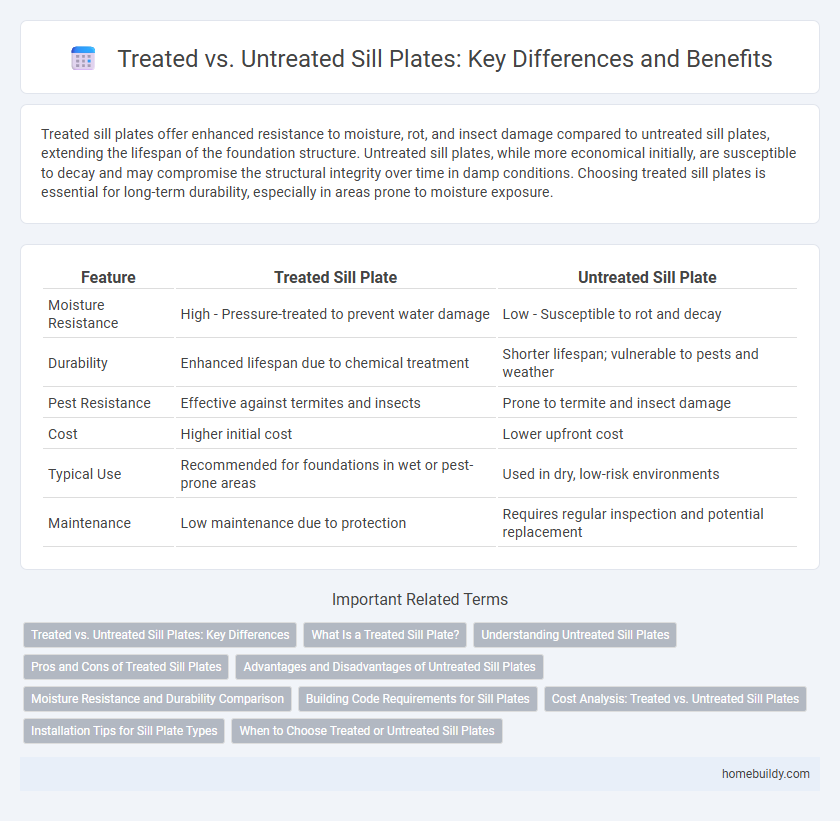Treated sill plates offer enhanced resistance to moisture, rot, and insect damage compared to untreated sill plates, extending the lifespan of the foundation structure. Untreated sill plates, while more economical initially, are susceptible to decay and may compromise the structural integrity over time in damp conditions. Choosing treated sill plates is essential for long-term durability, especially in areas prone to moisture exposure.
Table of Comparison
| Feature | Treated Sill Plate | Untreated Sill Plate |
|---|---|---|
| Moisture Resistance | High - Pressure-treated to prevent water damage | Low - Susceptible to rot and decay |
| Durability | Enhanced lifespan due to chemical treatment | Shorter lifespan; vulnerable to pests and weather |
| Pest Resistance | Effective against termites and insects | Prone to termite and insect damage |
| Cost | Higher initial cost | Lower upfront cost |
| Typical Use | Recommended for foundations in wet or pest-prone areas | Used in dry, low-risk environments |
| Maintenance | Low maintenance due to protection | Requires regular inspection and potential replacement |
Treated vs. Untreated Sill Plates: Key Differences
Treated sill plates are infused with preservatives to resist moisture, decay, and termite damage, extending the lifespan of the foundation. Untreated sill plates lack these protective chemicals, making them more susceptible to wood rot and pest infestation in humid or wet environments. Choosing treated sill plates enhances structural durability and reduces long-term maintenance costs compared to untreated options.
What Is a Treated Sill Plate?
A treated sill plate is a foundational wood component that has been pressure-treated with chemical preservatives to resist moisture, decay, and insect damage. Unlike untreated sill plates, which are vulnerable to rot and pest infestation, treated sill plates enhance the structural integrity and longevity of a building's foundation. These preservative treatments typically include copper-based compounds designed to protect the wood in contact with concrete and soil.
Understanding Untreated Sill Plates
Untreated sill plates are commonly made from standard lumber without chemical preservatives, making them vulnerable to moisture, rot, and insect damage, especially in humid or ground-contact environments. Unlike treated sill plates, which undergo pressure treatment with preservatives like copper azole or alkaline copper quaternary (ACQ), untreated sill plates lack protection against decay, reducing the structural integrity and lifespan of the foundation framing. Understanding the risks associated with untreated sill plates is crucial for builders aiming to prevent costly repairs and maintain building code compliance in areas prone to damp conditions.
Pros and Cons of Treated Sill Plates
Treated sill plates offer enhanced resistance to moisture, decay, and insect damage, significantly extending the lifespan of the foundation structure. Their chemical treatment safeguards wooden framing against mold and rot, especially in areas with high humidity or ground contact. However, treated sill plates may contain chemicals that require careful handling during installation and can be more expensive than untreated options.
Advantages and Disadvantages of Untreated Sill Plates
Untreated sill plates are more susceptible to moisture damage, decay, and insect infestations compared to treated sill plates, leading to reduced structural integrity over time. They offer cost savings upfront but often incur higher maintenance and replacement expenses due to vulnerability in damp or harsh environments. Untreated sill plates lack the chemical resistance of treated options, making them less durable in foundation construction.
Moisture Resistance and Durability Comparison
Treated sill plates offer superior moisture resistance compared to untreated sill plates, significantly reducing the risk of wood rot and mold development. Their enhanced durability extends the structural lifespan by preventing decay caused by prolonged exposure to damp conditions. Untreated sill plates, lacking chemical protection, are more susceptible to water damage, leading to premature deterioration and costly repairs.
Building Code Requirements for Sill Plates
Treated sill plates are required by most building codes for ground-contact applications to resist decay, insects, and moisture damage, ensuring structural integrity and longevity. Untreated sill plates are typically prohibited in contact with concrete or soil due to their vulnerability to rot and termite infestation, which can compromise the foundation framing. Compliance with International Residential Code (IRC) and local regulations mandates pressure-treated wood or naturally durable materials for sill plates in these environments to meet safety and durability standards.
Cost Analysis: Treated vs. Untreated Sill Plates
Treated sill plates typically cost 20-30% more than untreated ones due to the chemical preservatives used to resist moisture, decay, and insect damage. However, the higher upfront cost is offset by reduced maintenance expenses and longer lifespan, often extending service life by 15-20 years compared to untreated sill plates. Choosing treated sill plates can lead to significant long-term savings in repair and replacement costs, especially in humid or termite-prone environments.
Installation Tips for Sill Plate Types
Treated sill plates resist moisture and insect damage, making them ideal for installations in damp or crawl space environments. When installing treated sill plates, use corrosion-resistant fasteners and ensure a continuous moisture barrier to prevent mold growth and structural decay. Untreated sill plates require strict moisture control measures like vapor barriers and proper drainage to avoid rot and extend their lifespan.
When to Choose Treated or Untreated Sill Plates
Treated sill plates are essential in areas prone to moisture, pests, or decay, such as basements, crawl spaces, or exterior walls, providing enhanced durability and protection. Untreated sill plates may be suitable for dry, interior environments where exposure to water or insects is minimal, offering a cost-effective option without compromising structural integrity. Selecting treated or untreated sill plates depends on environmental conditions, building codes, and long-term resistance requirements.
Treated sill plate vs Untreated sill plate Infographic

 homebuildy.com
homebuildy.com